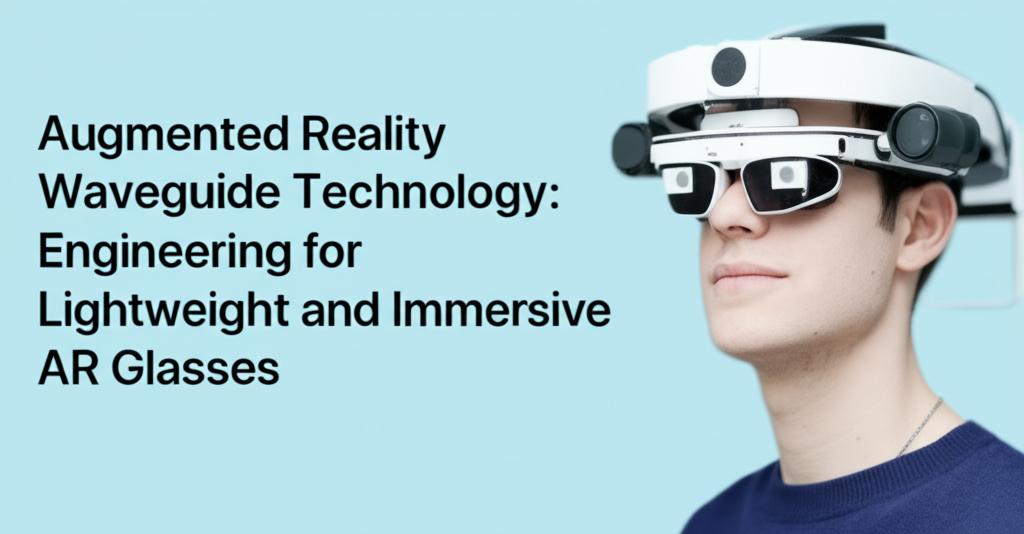Augmented reality (AR) is rapidly transforming how we interact with digital information, and at the heart of this evolution lies waveguide technology. Waveguides are critical components in AR glasses, directing virtual imagery to the user's eyes while allowing them to see the real world. The ongoing engineering efforts in this field are intensely focused on making AR glasses lighter, more comfortable for all-day wear, and capable of delivering truly immersive visual experiences.
The Core of AR Visuals: How Waveguides WorkWaveguide displays are the optical backbone of modern AR glasses. They project images into the user's field of view (FOV) while maintaining a slim and lightweight design, a crucial factor for user comfort and prolonged use. Unlike bulkier traditional AR/MR displays that need external components, waveguides guide light within the lens itself. This eliminates the need for extra mirrors or optical structures, allowing AR glasses to be as thin and light as regular eyeglasses.
The basic principle involves light from a microprojector entering the lens and propagating via total internal reflection (TIR). This light is then precisely directed to the user's pupil. Nanotechnology, often borrowed from the semiconductor industry, is leveraged to fine-tune light adjustments and achieve optimal image clarity and brightness. Two primary types of waveguide technology are diffractive and reflective, both using TIR to guide light from a microprojector to the user's eye.
Key Benefits of Waveguide Technology in AR Glasses:- Compact and Lightweight: By integrating the optical path directly into the lens, waveguides enable AR glasses to match the shape and weight of regular eyewear. This is a significant advantage over large headsets or awkwardly shaped devices.
- Optical See-Through Capability: Users can view virtual images overlaid onto their real-world surroundings, maintaining situational awareness.
- High Image Quality: Waveguide-based displays can deliver sharp, vibrant, and high-resolution images.
- Wider Field of View (FOV): Advancements in waveguide design are pushing towards larger FOVs, which is essential for a more natural and immersive AR experience. High refractive index materials are key to achieving wider FOVs.
A significant recent advancement comes from researchers at the Pohang University of Science and Technology (POSTECH). They have developed a single-layer achromatic metagrating waveguide. Traditionally, AR waveguides required multiple stacked layers of glass to guide different wavelengths of light (red, green, and blue), which added to the bulk and weight. This new technology consolidates these functions into a single ultrathin glass substrate.
The core of this innovation is an array of nanoscale silicon-nitride (Si₃N₄) pillars. The shape and arrangement of these pillars are optimized using sophisticated algorithms to precisely control light diffraction across the entire visible spectrum. This single-layer design, experimentally demonstrated at just 500 micrometers thick, can project vivid, full-color images and significantly reduces issues like chromatic aberration (color blur). It also promises simpler manufacturing processes, potentially lowering production costs.
Manufacturing Advancements and Material Innovations:The mass production of AR waveguides has been a significant challenge due to the complex fabrication techniques and the high precision required. However, progress is being made:
- High Refractive Index Materials: Glass manufacturers are developing materials with higher refractive indices to enable wider FOVs.
- Nanotechnology and Lithography: Precision engineering at the nanometer scale is crucial. For instance, some processes involve dispensing over 1.5 million picoliter-sized drops of grating material on a single six-inch wafer to create the necessary nano-gratings.
- 3D Printing: Novel approaches using 3D printing with ultra-clear transparent UV resin are being explored to create geometric optical waveguides at a lower cost and with greater design flexibility.
- Micro-Touch Manufacturing: Companies like Vuzix are refining their fabrication processes with techniques like "micro-touch" manufacturing during waveguide imprinting. This reduces forces that could damage materials, improves yield, and allows for the use of more fragile materials like polymers or thinner glass.
- Strategic Partnerships: Collaborations between optics companies (like SCHOTT and Lumus) are aimed at scaling up manufacturing capacity for technologies like reflective waveguides, making them more viable for the mass market.
The goal is to create AR glasses that are as comfortable and unobtrusive as regular eyeglasses, suitable for all-day wear. Achieving this involves overcoming several challenges:
- Reducing Bulk and Weight: Single-layer waveguides and lighter materials are key.
- Improving Visual Performance: This includes achieving higher resolution, better brightness and contrast (especially for outdoor use), wider FOV, and minimizing issues like color blur and distortion.
- User Comfort: Addressing factors like the vergence-accommodation conflict (a mismatch between the perceived distance of virtual objects and the eye's focusing distance) is crucial to prevent user fatigue and discomfort. Adaptive optics and eye-tracking are being explored to tackle this.
- Cost Reduction and Scalable Manufacturing: Making AR glasses affordable for the average consumer requires streamlining manufacturing processes and reducing material costs.
- Power Consumption: Efficient optical systems and displays are needed to ensure reasonable battery life.
Advancements in waveguide technology are unlocking new possibilities across numerous sectors:
- Consumer Electronics: The next generation of smart glasses aims to be the successor to smartphones, integrating AI and offering seamless digital interaction.
- Enterprise and Industrial: AR glasses can provide hands-free information, remote assistance, and training in fields like manufacturing, logistics, and maintenance.
- Healthcare: Surgeons could access real-time patient data overlaid on their view, and students could benefit from immersive medical training.
- Education and Entertainment: AR promises richer, more interactive learning experiences and novel gaming and entertainment possibilities.
The AR optical waveguide market is projected for significant growth, indicating a strong future for this technology. As innovations continue to shrink the form factor, enhance visual fidelity, and reduce costs, AR glasses are poised to move from niche gadgets to ubiquitous tools, seamlessly blending our digital and physical realities. Companies like Magic Leap, Microsoft, Vuzix, and OPTIX, among others, are actively pushing the boundaries of what's possible with AR waveguide technology. The continuous improvement in display and waveguide technologies will be pivotal in creating AR devices that offer exceptional user experiences.

